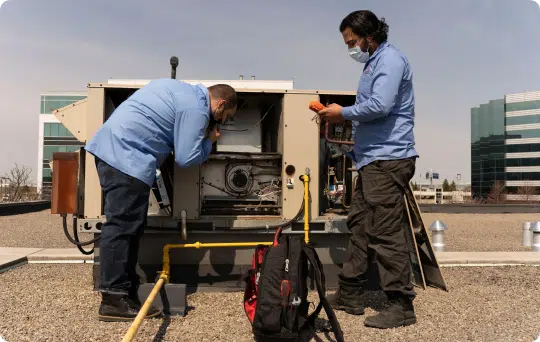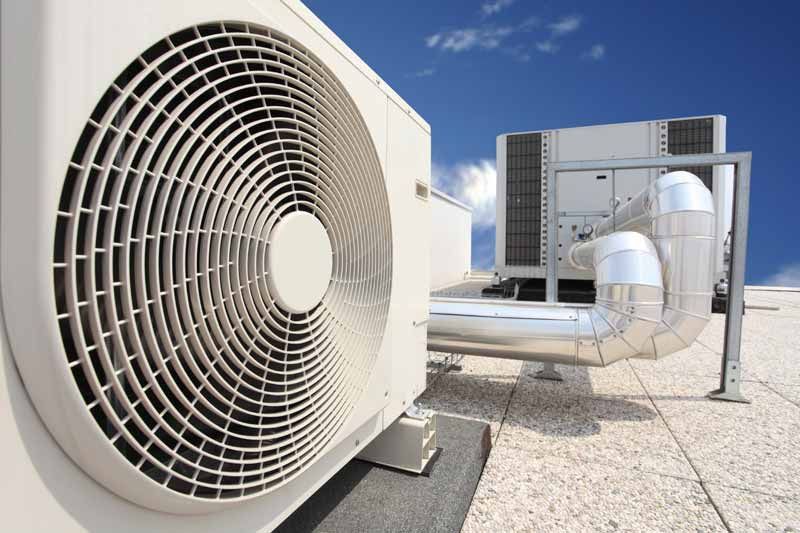Exactly How a Heat Pump and Heater Collaborate to Enhance Your Home's Home heating Effectiveness
Comprehending just how a warmth pump and heating system interact is crucial for property owners looking for efficient home heating remedies. Each system has its staminas, giving a well balanced strategy to home comfort. The warmth pump stands out in moderate temperature levels, while the furnace supplies fast warmth during extreme cold. This synergy not only reduces power prices yet also boosts the lifespan of both devices. What variables affect this cooperation, and exactly how can property owners optimize their advantages?
Understanding Heat Pumps: How They Work
Numerous individuals might be unknown with their internal operations, heat pumps play an important function in modern-day heating systems. These gadgets operate by transferring heat from one area to one more, utilizing the concepts of thermodynamics. In colder months, a warm pump removes warm from the outdoors air, ground, or water, and transfers it inside to warm up the home. Conversely, throughout warmer months, it can reverse the process, functioning as an ac unit by getting rid of warm from inside to the outside.Heat pumps consist of an evaporator, condenser, compressor, and expansion valve. The cooling agent within the system absorbs heat as it vaporizes at low temperatures and pressures. The compressor then raises the pressure and temperature level of the cooling agent, enabling it to release heat as it condenses. This reliable procedure can greatly minimize power intake compared to conventional home heating techniques, making warm pumps a sustainable option for environment control in homes.
The Duty of Heaters in Home Heating
Heaters play a necessary duty in home heating by supplying a dependable source of heat during the chillier months. They run by generating warm through burning or electric resistance, dispersing it throughout the home via ducts or radiant systems. The effectiveness of a heater is usually determined by its Annual Fuel Use Performance (AFUE) score, which indicates just how efficiently the unit converts fuel right into heat.Furnaces can utilize numerous energy resources, consisting of gas, oil, lp, or power, allowing property owners to select one of the most ideal option for their demands. Unlike heatpump, which may battle in extreme cold, furnaces preserve constant efficiency, ensuring that indoor temperatures stay comfortable despite outside conditions. Furthermore, contemporary furnaces usually come geared up with advanced innovation, such as wise thermostats and variable-speed blowers, improving their efficiency and responsiveness. This adaptability makes heaters an essential component in all-encompassing home heating techniques.

Benefits of Making Use Of Both Equipments With Each Other
Integrating the toughness of both heating systems and heat pumps can bring about a much more efficient and reliable home heating option. Making use of both systems enables property owners to take benefit of the heatpump's power effectiveness during milder temperature levels while relying upon the furnace for more extreme cold problems. This dual method can significantly minimize power prices, as warm pumps eat much less electricity than conventional heating approaches when temperature levels are moderate.Additionally, making use of both systems with each other can boost convenience degrees in the home. Heatpump can provide constant, even heating, while heaters can swiftly elevate ambient temperatures when required. Additionally, the assimilation of both systems can prolong the lifespan of devices by lowering deterioration on each unit, as they share the workload. Eventually, home owners can enjoy a well balanced, affordable home heating solution that adjusts flawlessly to varying weather, making sure a warm and welcoming home throughout the cold weather.
Exactly How Heat Pumps and Furnaces Complement Each Various Other
When house owners integrate warm pumps and furnaces, they produce a complementary furnace that takes full advantage of efficiency and convenience. Warm pumps run by moving warmth from the outdoors air or ground, making them highly effective in modest environments. They succeed during milder temperatures, giving affordable heating. On the other hand, heaters produce warmth with burning or electric resistance, supplying solid, immediate warmth throughout extreme cool conditions.The combination of these two systems allows for dynamic adjustments based on temperature level variations. During warmer months or milder winter days, the heatpump can take the lead, conserving energy and lowering costs. As temperatures drop, the heater can effortlessly involve, making sure regular heat throughout the home. This synergy not just maximizes energy usage but also boosts the lifespan of both systems, as each unit runs within its suitable performance array. Together, they a fantastic read create a well balanced environment that adjusts to differing climate demands.
Enhancing Performance: Tips for Homeowners
House owners can improve their heating effectiveness via several useful techniques. Developing a routine maintenance schedule, integrating clever thermostat innovation, and applying efficient insulation and sealing options are key steps. These steps not just enhance convenience however also minimize power prices.
Regular Upkeep Arrange
To guarantee maximum heating efficiency, establishing a normal maintenance routine is important for any type of home. Homeowners should prioritize regular inspections of both heatpump and heaters to ascertain peak efficiency. This consists of altering air filters each to 3 months, as blocked filters can greatly minimize efficiency. Additionally, scheduling professional upkeep at the very least annually allows professionals to recognize and resolve potential concerns prior to they rise. Property owners must also clean the warmth pump's outdoor system to protect against particles build-up that can hinder air flow. By adhering to a normal maintenance routine, house owners not only enhance their heater' performance yet additionally expand their life expectancy, that site leading to higher convenience and lowered energy expenses throughout the chillier months.
Smart Thermostat Assimilation
Integrating a smart thermostat into a home heating system can significantly enhance energy performance, particularly as it enables for accurate control over temperature settings. These tools can find out the property owner's timetable and preferences, immediately changing the temperature level to enhance convenience while lessening energy usage. They can decrease home heating during times when the home is vacant, reducing unneeded usage. Lots of clever thermostats also provide real-time power use data, enabling house owners to make educated choices regarding their heating practices. In addition, remote gain access to using smartphone apps permits customers to adjust settings from anywhere, making certain the home is warm upon return. In general, smart thermostat combination not just improves comfort yet considerably adds to energy financial savings and effectiveness.
Insulation and Sealing Solutions
Smart thermostats play an important role in energy efficiency, but their effectiveness can be considerably enhanced by proper insulation and securing remedies. Property owners ought to focus on shielding attics, floors, and wall surfaces to reduce heat loss. Top notch insulation products, such as spray foam or fiberglass, can greatly enhance thermal resistance. Additionally, sealing spaces around home windows, air ducts, and doors prevents cold air infiltration and warm escape. Weatherstripping and caulking work methods for dealing with these leaks - ductless mini splits. Regular evaluations for air leaks, along with the usage of blower door tests, can assist recognize problem locations. By purchasing insulation and securing, homeowners can enhance the performance of their furnace, inevitably causing minimized energy intake and reduced utility bills
Usual Myths Concerning Warmth Pumps and Furnaces
What misunderstandings border heat pumps and furnaces? Numerous individuals wrongly think that heatpump are ineffective in cooler environments. Actually, modern-day warm pumps are created to run efficiently even in reduced temperature levels, providing trustworthy heating throughout wintertime. One more common myth is that heaters are constantly extra efficient than heatpump. Nonetheless, this depends upon the certain power sources and effectiveness rankings of the devices concerned. Some might additionally think that making use of both systems simultaneously is unnecessary, yet actually, this mix can optimize heating performance, specifically throughout extreme climate problems. Furthermore, individuals often think that heatpump require continuous upkeep, when in reality, they have comparable upkeep needs to traditional heater. By debunking these misconceptions, home owners can make more informed decisions concerning their heating choices, eventually causing enhanced comfort and power effectiveness in their homes.
Upkeep Factors To Consider for Combined Equipments

Frequently Asked Questions
Can Warm Pumps Job Successfully in Incredibly Cold Climates?
Warmth pumps can battle in very cool climates due to minimized performance and warmth extraction limitations. Nonetheless, developments in technology have actually caused versions made for better efficiency in such conditions, boosting their practicality in extreme atmospheres.
For How Long Do Heat Pumps and Furnaces Usually Last?
Heatpump generally last 15 to two decades, while furnaces have a life-span of 15 to thirty years. Regular upkeep can extend their longevity, making sure reliable operation and lowering the need for early substitutes.

What Is the Ordinary Cost of Installing Both Equipments?
The ordinary cost of setting up both a heatpump and a heater usually varies in between $5,000 to $10,000 - heat pump replacement view website ooltewah tn. Aspects influencing this expense include system size, installation intricacy, and local labor prices
Exist Tax Obligation Rewards for Making Use Of Energy-Efficient Heating Solutions?
Many house owners inquire about tax motivations for energy-efficient furnace. Various federal and state programs often offer discounts or credit scores, encouraging the fostering of lasting modern technologies to reduce energy consumption and promote environmental duty.
Exactly how Do I Pick the Right Size Heatpump and Heater?
Picking the appropriate size warm pump and heating system involves calculating the home's square video footage, taking into consideration insulation high quality, and assessing regional environment. Consulting a specialist can guarantee perfect system performance and power effectiveness based upon certain requirements. ductless mini splits. Understanding exactly how a heat pump and heater job together is important for homeowners looking for reliable home heating remedies. In cooler months, a heat pump removes warm from the outdoors air, ground, or water, and transfers it inside your home to warm the living room. When homeowners incorporate heat pumps and heaters, they create a corresponding home heating system that maximizes effectiveness and comfort. Heat pumps run by moving warmth from the outside air or ground, making them very efficient in moderate environments. Warm pumps can battle in extremely chilly environments due to decreased performance and heat removal restrictions